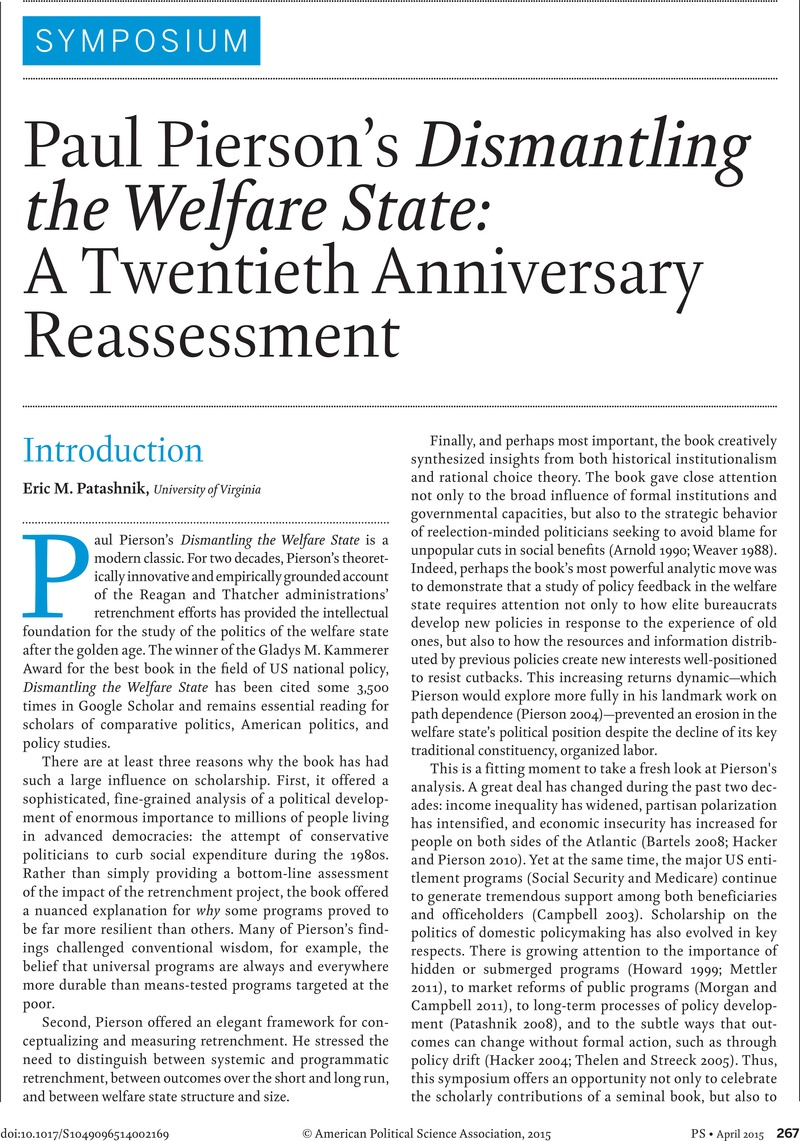No CrossRef data available.
Article contents
Paul Pierson’s Dismantling the Welfare State: A Twentieth Anniversary Reassessment
Introduction
Published online by Cambridge University Press: 02 April 2015
Abstract
An abstract is not available for this content so a preview has been provided. Please use the Get access link above for information on how to access this content.

- Type
- Symposium: Paul Pierson’s Dismantling the Welfare State: A Twentieth Anniversary Reassessment
- Information
- Copyright
- Copyright © American Political Science Association 2015
References
REFERENCES
Arnold, R. Douglas. 1990. The Logic of Congressional Action. New Haven, CT: Yale University Press.Google Scholar
Bartels, Larry. 2008. Unequal Democracy: The Political Economy of the New Gilded Age. Princeton, NJ: Princeton University Press.Google Scholar
Campbell, Andrea Louise. 2003. How Policies Make Citizens: Senior Political Activism and the American Welfare State. Princeton, NJ: Princeton University Press.Google Scholar
Hacker, Jacob S. 2004. “Privatizing Risk without Privatizing the Welfare State: The Hidden Politics of Social Policy Retrenchment in the United States.” American Political Science Review
98 (2): 243–60.Google Scholar
Hacker, Jacob S., and Pierson, Paul. 2010. Winner-Take-All Politics: How Washington Made the Rich Richer and Turned Its Back on the Middle Class. New York: Simon and Schuster.Google Scholar
Howard, Christopher. 1999. The Hidden Welfare State: Tax Expenditures and Social Policy in the United States. Princeton, NJ: Princeton University Press.Google Scholar
Mettler, Suzanne. 2011. The Submerged State: How Invisible Government Policies Undermine American Democracy. Chicago: University of Chicago Press.Google Scholar
Morgan, Kimberly J., and Campbell, Andrea Louise. 2011. The Delegated Welfare State: Medicare, Markets, and the Governance of Social Policy. New York: Oxford University Press.CrossRefGoogle Scholar
Patashnik, Eric M. 2008. Reforms at Risk: What Happens After Major Policy Changes Are Enacted. Princeton, NJ: Princeton University Press.Google Scholar
Pierson, Paul. 2004. Politics in Time: History, Institutions, and Social Analysis
Princeton, NJ: Princeton University Press.CrossRefGoogle Scholar
Skocpol, Theda. 1992. Protecting Soldiers and Mothers: The Political Origins of Social Policy in the United States. Cambridge, MA: Belknap Press of Harvard University Press.CrossRefGoogle Scholar
Thelen, Kathleen, and Streeck, Wolfgang, eds. 2005. Beyond Continuity: Institutional Change in Advanced Political Economies. New York: Oxford University Press.Google Scholar
Weaver, R. Kent. 1988. Automatic Government: The Politics of Indexation. Washington, DC: The Brookings Institution.Google Scholar
Weir, Margaret, and Skocpol, Theda. 1985. “State Structures and the Possibilities for ‘Keynesian’ Responses to the Great Depression in Sweden, Britain, and the United States.” In Bringing the State Back In, ed. Evans, Peter B., Rueschemeyer, Dietrich, and Skocpol., Theda
Cambridge: Cambridge University Press.Google Scholar


